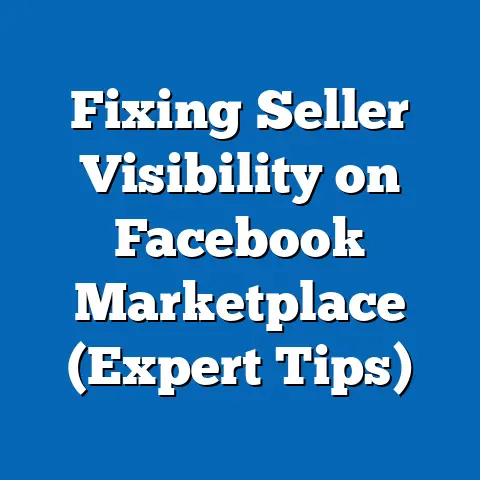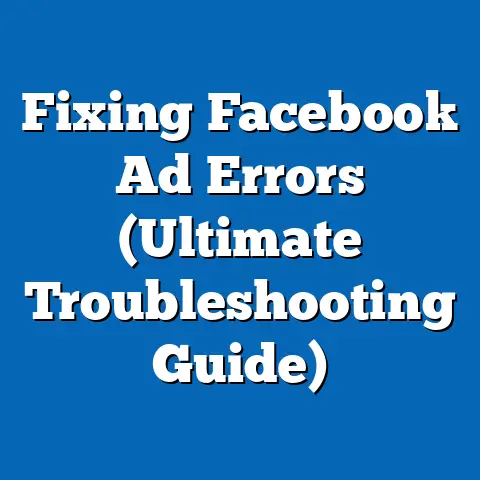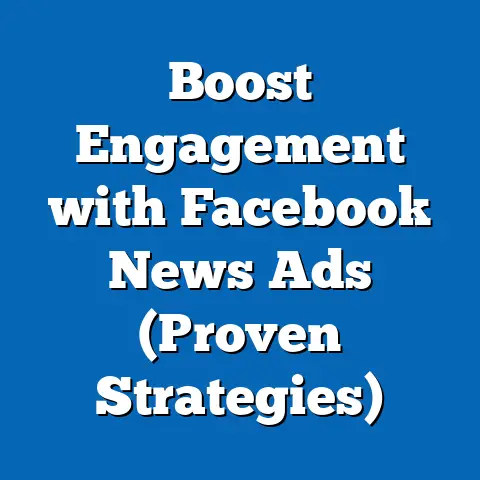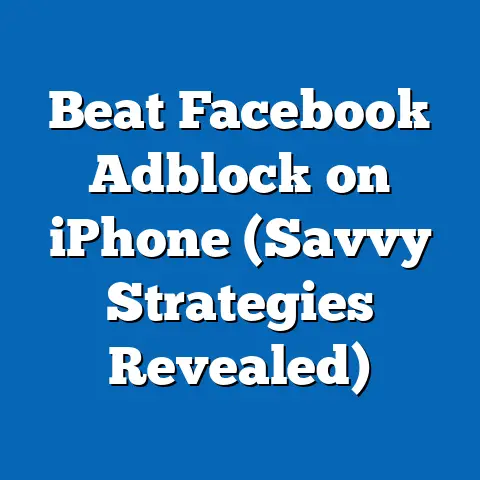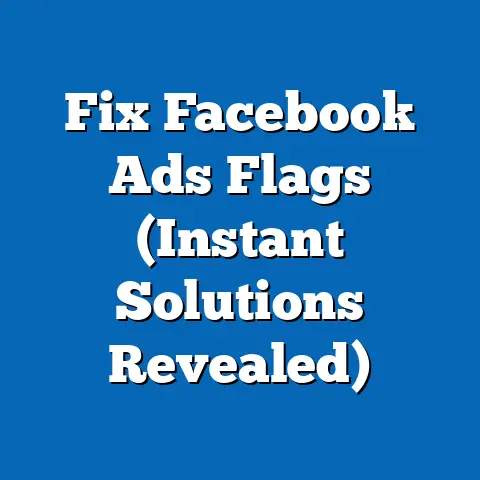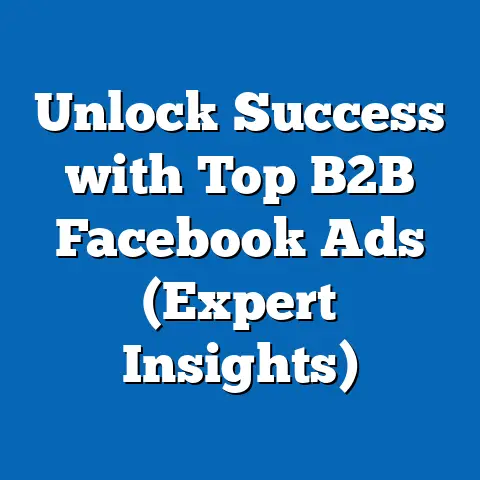Optimize Facebook Ads Campaigns (Expert Strategies Inside)
The world of digital marketing is a constantly evolving landscape, and nowhere is this more evident than in the realm of Facebook advertising. What sets Facebook Ads apart is its remarkable agility – the ease with which I, as a marketer, can pivot and adjust campaigns based on real-time data. Think of it like steering a ship: you’re not locked into a predetermined course; instead, you can make micro-adjustments based on the winds and currents. Facebook Ads offers precisely this kind of unparalleled flexibility and tools that allow advertisers to quickly implement changes, ensuring that they can respond to market trends, audience behavior, and ad performance.
I’ve seen firsthand how crucial this adaptability is. In one instance, I was running a campaign for a local bakery promoting a seasonal pie. Initial targeting was broad, based on general interests like “baking” and “desserts.” However, after just a few days, the data revealed that the ads resonated most strongly with women aged 35-55 living within a 5-mile radius of the bakery. I was able to immediately refine my targeting, increase the budget for this segment, and see a significant jump in conversions.
This experience highlighted the power of real-time optimization. Mastering these techniques can dramatically enhance your campaign effectiveness and ROI. It’s about understanding the platform’s capabilities, analyzing the data, and being willing to adapt your strategy on the fly. In this guide, I’ll share expert strategies to help you unlock the full potential of Facebook Ads and drive tangible results for your business.
Understanding Facebook Ads
Facebook Ads is a powerhouse in the digital marketing world, offering businesses of all sizes a platform to reach a massive and highly engaged audience. With billions of active users, Facebook provides unparalleled opportunities for targeted advertising. But before diving into the specifics, let’s break down the key components that make up this advertising ecosystem.
-
Ad Formats: Facebook offers a diverse range of ad formats to suit different marketing objectives and creative styles. These include:
- Image Ads: Simple yet effective, image ads are perfect for showcasing products or services with compelling visuals.
- Video Ads: Captivating and dynamic, video ads are ideal for telling stories and capturing attention in a crowded newsfeed.
- Carousel Ads: Allow you to display multiple images or videos in a single ad, perfect for showcasing a range of products or highlighting different features.
- Slideshow Ads: Create a video-like experience using a series of images, a cost-effective alternative to traditional video ads.
- Collection Ads: Designed for e-commerce businesses, collection ads allow users to browse and purchase products directly from the ad.
-
Targeting Options: One of Facebook’s greatest strengths is its granular targeting capabilities. You can reach your ideal audience based on:
-
Demographics: Target users based on age, gender, location, education, and other demographic factors.
- Interests: Reach users based on their expressed interests, hobbies, and passions.
- Behaviors: Target users based on their online and offline behaviors, such as purchase history, travel habits, and device usage.
- Custom Audiences: Upload your own customer data to create targeted audiences based on existing customer relationships.
- Lookalike Audiences: Expand your reach by targeting users who share similar characteristics with your existing customers.
-
Facebook Ads Manager: The central hub for creating, managing, and analyzing your Facebook Ads campaigns. It provides a comprehensive interface for:
-
Setting up campaigns and ad sets
- Defining your target audience
- Choosing your ad formats
- Setting your budget and bidding strategy
- Tracking your campaign performance
Ad Formats: Facebook offers a diverse range of ad formats to suit different marketing objectives and creative styles. These include:
- Image Ads: Simple yet effective, image ads are perfect for showcasing products or services with compelling visuals.
- Video Ads: Captivating and dynamic, video ads are ideal for telling stories and capturing attention in a crowded newsfeed.
- Carousel Ads: Allow you to display multiple images or videos in a single ad, perfect for showcasing a range of products or highlighting different features.
- Slideshow Ads: Create a video-like experience using a series of images, a cost-effective alternative to traditional video ads.
- Collection Ads: Designed for e-commerce businesses, collection ads allow users to browse and purchase products directly from the ad.
-
Targeting Options: One of Facebook’s greatest strengths is its granular targeting capabilities. You can reach your ideal audience based on:
-
Demographics: Target users based on age, gender, location, education, and other demographic factors.
- Interests: Reach users based on their expressed interests, hobbies, and passions.
- Behaviors: Target users based on their online and offline behaviors, such as purchase history, travel habits, and device usage.
- Custom Audiences: Upload your own customer data to create targeted audiences based on existing customer relationships.
- Lookalike Audiences: Expand your reach by targeting users who share similar characteristics with your existing customers.
-
Facebook Ads Manager: The central hub for creating, managing, and analyzing your Facebook Ads campaigns. It provides a comprehensive interface for:
-
Setting up campaigns and ad sets
- Defining your target audience
- Choosing your ad formats
- Setting your budget and bidding strategy
- Tracking your campaign performance
Targeting Options: One of Facebook’s greatest strengths is its granular targeting capabilities. You can reach your ideal audience based on:
Demographics: Target users based on age, gender, location, education, and other demographic factors.
Facebook Ads Manager: The central hub for creating, managing, and analyzing your Facebook Ads campaigns. It provides a comprehensive interface for:
Setting up campaigns and ad sets
Navigating the Ads Manager can seem daunting at first, but it’s the key to unlocking the full potential of Facebook advertising. I encourage you to spend some time exploring the interface and familiarizing yourself with its various features.
Key Takeaway: Facebook Ads offers a powerful platform for reaching a vast and highly targeted audience. Understanding the different ad formats, targeting options, and the Ads Manager interface is crucial for building effective campaigns.
Setting Clear Campaign Objectives
Before you even think about crafting your ad creative or selecting your target audience, you need to define clear campaign objectives. What do you want to achieve with your Facebook Ads campaign? Are you looking to increase brand awareness, generate leads, drive conversions, or boost sales?
The objective you choose will have a significant impact on your entire campaign strategy, influencing everything from your ad design to your target audience selection. Facebook offers a range of campaign objectives, each designed to optimize for specific outcomes:
- Awareness: Ideal for reaching a broad audience and increasing brand recognition.
- Brand Awareness: Show your ads to people who are most likely to remember them.
- Reach: Show your ads to the maximum number of people within your target audience.
- Consideration: Focuses on driving engagement and interest in your business.
- Traffic: Drive traffic to your website, app, or Facebook Page.
- Engagement: Increase likes, comments, shares, and other forms of engagement on your ads or Page.
- App Installs: Encourage users to download and install your mobile app.
- Video Views: Maximize the number of people who watch your video content.
- Lead Generation: Collect leads directly from Facebook using lead forms.
- Messages: Encourage users to start conversations with your business on Messenger.
- Conversion: Aims to drive specific actions, such as purchases or sign-ups.
- Conversions: Drive valuable actions on your website, app, or Messenger.
- Catalog Sales: Promote products from your e-commerce catalog to drive sales.
- Store Traffic: Drive foot traffic to your physical stores.
- Brand Awareness: Show your ads to people who are most likely to remember them.
- Reach: Show your ads to the maximum number of people within your target audience.
- Traffic: Drive traffic to your website, app, or Facebook Page.
- Engagement: Increase likes, comments, shares, and other forms of engagement on your ads or Page.
- App Installs: Encourage users to download and install your mobile app.
- Video Views: Maximize the number of people who watch your video content.
- Lead Generation: Collect leads directly from Facebook using lead forms.
- Messages: Encourage users to start conversations with your business on Messenger.
- Conversions: Drive valuable actions on your website, app, or Messenger.
- Catalog Sales: Promote products from your e-commerce catalog to drive sales.
- Store Traffic: Drive foot traffic to your physical stores.
For example, if your goal is to generate leads for your business, you would choose the “Lead Generation” objective. This will prompt Facebook to optimize your ads for lead form submissions, showing them to users who are most likely to fill out the form. On the other hand, if your goal is to drive sales on your e-commerce website, you would choose the “Conversions” objective and set up conversion tracking to measure purchases.
I remember working with a client who was launching a new online course. Initially, they chose the “Traffic” objective, hoping to drive as many people as possible to their website. However, they quickly realized that simply driving traffic wasn’t enough; they needed to attract qualified leads who were likely to enroll in the course. We switched to the “Lead Generation” objective and created a lead form that captured information about their interests and experience. This resulted in a significant improvement in the quality of leads and ultimately led to more course enrollments.
Key Takeaway: Setting clear campaign objectives is crucial for aligning your advertising efforts with your business goals. Choose the objective that best reflects the desired outcome and tailor your ad design, target audience selection, and overall strategy accordingly.
Leveraging Audience Insights
Understanding your audience is paramount to the success of any Facebook Ads campaign. Without a deep understanding of their demographics, interests, and behaviors, you’re essentially throwing darts in the dark. Fortunately, Facebook provides a wealth of tools and resources to help you gain valuable audience insights.
- Facebook Insights: Provides data about your existing Facebook Page audience, including demographics, interests, and engagement patterns. This information can help you understand who is already interacting with your brand and what content resonates with them.
-
Audience Insights: A powerful tool for exploring potential audiences on Facebook. It allows you to analyze the characteristics and behaviors of users based on their interests, demographics, and connections. You can use Audience Insights to:
- Identify potential target audiences for your ads
- Understand their interests and preferences
- Discover new opportunities for targeting
-
Custom Audiences: Allow you to target specific groups of people based on your own data. You can create custom audiences by:
-
Uploading a customer list (email addresses, phone numbers, etc.)
- Targeting website visitors who have taken specific actions (e.g., visited a product page, added items to their cart)
- Targeting users who have engaged with your Facebook Page or ads
-
Lookalike Audiences: Expand your reach by targeting users who share similar characteristics with your existing customers. You can create lookalike audiences based on:
-
Your customer list
- Your website visitors
- Your Facebook Page fans
Audience Insights: A powerful tool for exploring potential audiences on Facebook. It allows you to analyze the characteristics and behaviors of users based on their interests, demographics, and connections. You can use Audience Insights to:
- Identify potential target audiences for your ads
- Understand their interests and preferences
- Discover new opportunities for targeting
-
Custom Audiences: Allow you to target specific groups of people based on your own data. You can create custom audiences by:
-
Uploading a customer list (email addresses, phone numbers, etc.)
- Targeting website visitors who have taken specific actions (e.g., visited a product page, added items to their cart)
- Targeting users who have engaged with your Facebook Page or ads
-
Lookalike Audiences: Expand your reach by targeting users who share similar characteristics with your existing customers. You can create lookalike audiences based on:
-
Your customer list
- Your website visitors
- Your Facebook Page fans
Custom Audiences: Allow you to target specific groups of people based on your own data. You can create custom audiences by:
Uploading a customer list (email addresses, phone numbers, etc.)
Lookalike Audiences: Expand your reach by targeting users who share similar characteristics with your existing customers. You can create lookalike audiences based on:
Your customer list
I’ve found that creating custom and lookalike audiences is one of the most effective ways to improve the performance of my Facebook Ads campaigns. By targeting users who are already familiar with my brand or who share similar characteristics with my existing customers, I can significantly increase the relevance and effectiveness of my ads.
For instance, I worked with an e-commerce business that was struggling to generate sales. They had a large email list of past customers, but they weren’t effectively leveraging this data in their Facebook Ads campaigns. I helped them create a custom audience based on their email list and then created a lookalike audience based on that custom audience. The results were remarkable. The lookalike audience performed significantly better than their previously targeted audiences, resulting in a substantial increase in sales and ROI.
Key Takeaway: Audience research and insights are essential for building effective Facebook Ads campaigns. Utilize Facebook Insights, Audience Insights, and custom/lookalike audiences to understand your target audience and tailor your ads accordingly.
Crafting Compelling Ad Creatives
Even with the most precise targeting, your Facebook Ads will fall flat if your ad creatives aren’t compelling. Your ad creative is the first thing users see, and it plays a crucial role in capturing their attention and driving engagement.
- Visual Storytelling: Use high-quality images or videos that tell a story and resonate with your target audience. Avoid generic stock photos and instead focus on visuals that are authentic and engaging.
- Effective Ad Copy: Write clear, concise, and persuasive ad copy that highlights the benefits of your product or service. Use strong calls to action to encourage users to take the desired action (e.g., “Shop Now,” “Learn More,” “Sign Up”).
- A/B Testing: Experiment with different ad creatives to determine what works best. Test different headlines, images, videos, and calls to action to see which combinations generate the highest engagement and conversions.
- Video Content: Leverage the power of video to capture attention and tell your brand story. Video ads are particularly effective for showcasing products, demonstrating features, and building brand awareness.
- Interactive Formats: Consider using interactive ad formats, such as polls or quizzes, to boost engagement and encourage users to interact with your ads.
I’ve learned that a strong visual is often the most important element of a successful Facebook Ad. People are naturally drawn to images and videos, so it’s crucial to make sure your visuals are high-quality, eye-catching, and relevant to your target audience.
I once ran a campaign for a travel agency promoting a new vacation package. Initially, we used a generic stock photo of a beach, but the ad performance was underwhelming. We then decided to use a photo taken by a real traveler who had recently visited the destination. The new ad featured a stunning image of the traveler enjoying a sunset on the beach, and it immediately resonated with our target audience. The ad performance skyrocketed, resulting in a significant increase in bookings.
Key Takeaway: Crafting compelling ad creatives is essential for capturing attention and driving engagement. Focus on visual storytelling, effective ad copy, A/B testing, video content, and interactive formats to create ads that resonate with your target audience.
Budgeting and Bidding Strategies
Setting a budget and choosing the right bidding strategy are critical for maximizing the return on your Facebook Ads investment. Without a clear understanding of these concepts, you risk overspending or underperforming.
- Daily vs. Lifetime Budgets:
- Daily Budget: Sets the average amount you’re willing to spend each day.
- Lifetime Budget: Sets the total amount you’re willing to spend over the entire duration of your campaign.
- Bidding Strategies:
- Cost Per Click (CPC): You pay each time someone clicks on your ad.
- Cost Per Thousand Impressions (CPM): You pay for every 1,000 times your ad is shown.
- Automated Bidding: Facebook automatically sets your bids to maximize your results based on your campaign objective.
- Budget Optimization:
- Campaign Budget Optimization (CBO): Allows Facebook to automatically distribute your budget across your ad sets to maximize overall campaign performance.
- Ad Set Budget Optimization: Sets a specific budget for each ad set within your campaign.
- Daily Budget: Sets the average amount you’re willing to spend each day.
- Lifetime Budget: Sets the total amount you’re willing to spend over the entire duration of your campaign.
- Cost Per Click (CPC): You pay each time someone clicks on your ad.
- Cost Per Thousand Impressions (CPM): You pay for every 1,000 times your ad is shown.
- Automated Bidding: Facebook automatically sets your bids to maximize your results based on your campaign objective.
- Campaign Budget Optimization (CBO): Allows Facebook to automatically distribute your budget across your ad sets to maximize overall campaign performance.
- Ad Set Budget Optimization: Sets a specific budget for each ad set within your campaign.
Choosing the right budget and bidding strategy depends on your campaign objectives, target audience, and overall marketing goals. If you’re focused on driving traffic to your website, CPC bidding may be the best option. If you’re focused on increasing brand awareness, CPM bidding may be more effective. Automated bidding can be a good option if you’re new to Facebook Ads or if you want to let Facebook optimize your bids for you.
I’ve found that Campaign Budget Optimization (CBO) can be a powerful tool for maximizing campaign performance. CBO allows Facebook to automatically allocate your budget to the ad sets that are performing best, ensuring that you’re getting the most bang for your buck.
In one instance, I was running a campaign for a clothing retailer with multiple ad sets targeting different demographics. Initially, I set a specific budget for each ad set. However, I noticed that some ad sets were consistently outperforming others. I decided to switch to CBO, allowing Facebook to automatically allocate the budget to the top-performing ad sets. The results were impressive. Overall campaign performance improved significantly, resulting in a higher ROI.
Key Takeaway: Proper budgeting and bidding are essential for maximizing the return on your Facebook Ads investment. Understand the different budget options and bidding strategies available and choose the ones that best align with your campaign objectives. Consider using Campaign Budget Optimization (CBO) to let Facebook optimize your budget allocation for you.
Monitoring and Analyzing Performance
Launching your Facebook Ads campaign is just the first step. To truly optimize your campaigns, you need to continuously monitor and analyze their performance. This involves tracking key performance indicators (KPIs) and making data-driven decisions to improve your results.
- Key Performance Indicators (KPIs):
- Click-Through Rate (CTR): The percentage of people who see your ad and click on it.
- Conversion Rate: The percentage of people who click on your ad and complete a desired action (e.g., purchase, sign-up).
- Cost Per Click (CPC): The average cost you pay for each click on your ad.
- Cost Per Conversion (CPC): The average cost you pay for each conversion.
- Return on Ad Spend (ROAS): The amount of revenue you generate for every dollar you spend on advertising.
-
Facebook Ads Manager: Provides a wealth of data and analytics to help you track your campaign performance. You can use the Ads Manager to:
- Monitor your KPIs in real-time
- Track the performance of individual ads and ad sets
- Analyze audience demographics and behaviors
- Identify trends and patterns
-
Third-Party Analytics Tools: Can provide additional insights into your campaign performance. These tools can help you:
-
Track website traffic and conversions
- Analyze user behavior on your website
- Measure the impact of your Facebook Ads on your overall marketing efforts
- Click-Through Rate (CTR): The percentage of people who see your ad and click on it.
- Conversion Rate: The percentage of people who click on your ad and complete a desired action (e.g., purchase, sign-up).
- Cost Per Click (CPC): The average cost you pay for each click on your ad.
- Cost Per Conversion (CPC): The average cost you pay for each conversion.
- Return on Ad Spend (ROAS): The amount of revenue you generate for every dollar you spend on advertising.
Facebook Ads Manager: Provides a wealth of data and analytics to help you track your campaign performance. You can use the Ads Manager to:
- Monitor your KPIs in real-time
- Track the performance of individual ads and ad sets
- Analyze audience demographics and behaviors
- Identify trends and patterns
-
Third-Party Analytics Tools: Can provide additional insights into your campaign performance. These tools can help you:
-
Track website traffic and conversions
- Analyze user behavior on your website
- Measure the impact of your Facebook Ads on your overall marketing efforts
Third-Party Analytics Tools: Can provide additional insights into your campaign performance. These tools can help you:
Track website traffic and conversions
I always emphasize the importance of data-driven decision-making. Don’t rely on gut feelings or assumptions; instead, let the data guide your optimization efforts. By continuously monitoring your KPIs and analyzing your campaign performance, you can identify areas for improvement and make adjustments that will lead to better results.
I recall working with a client who was struggling to generate sales through their Facebook Ads campaigns. They were running ads with a high CTR, but their conversion rate was very low. After analyzing their website data, I discovered that their landing page was poorly designed and difficult to navigate. I recommended that they redesign their landing page to improve the user experience. They implemented my recommendations, and their conversion rate skyrocketed, resulting in a significant increase in sales.
Key Takeaway: Ongoing monitoring and analysis of ad performance are essential for optimizing your Facebook Ads campaigns. Track key performance indicators (KPIs), use Facebook Ads Manager and third-party analytics tools to gain insights into campaign performance, and make data-driven decisions to continuously improve your results.
Scaling Successful Campaigns
Once you’ve identified successful Facebook Ads campaigns, the next step is to scale them to reach a larger audience and generate even more results. Scaling your campaigns involves increasing your budget, expanding your audience reach, and testing new ad formats or placements.
- Increase Budget Allocation: Gradually increase the budget for your high-performing ads and ad sets. Monitor your KPIs closely to ensure that your performance doesn’t decline as you increase your budget.
- Expand Audience Reach: Create lookalike audiences based on your existing customer data or website visitors to reach a larger audience that shares similar characteristics with your best customers.
- Test New Ad Formats or Placements: Experiment with different ad formats (e.g., video ads, carousel ads) or placements (e.g., Instagram, Audience Network) to see if you can improve your results.
- Retargeting: Re-engage users who have interacted with your previous ads or visited your website. Retargeting can be a highly effective way to drive conversions and increase sales.
Scaling your Facebook Ads campaigns requires a careful and strategic approach. It’s important to gradually increase your budget and monitor your KPIs closely to ensure that your performance doesn’t decline. It’s also important to test new ad formats and placements to see if you can improve your results.
I’ve found that retargeting is one of the most effective strategies for scaling successful Facebook Ads campaigns. By retargeting users who have already shown an interest in your products or services, you can significantly increase your conversion rate and drive more sales.
I worked with an e-commerce business that was running retargeting ads to users who had added items to their cart but hadn’t completed the purchase. The retargeting ads featured a special discount or free shipping offer to encourage users to complete their purchase. The results were remarkable. The retargeting ads had a significantly higher conversion rate than their other ads, resulting in a substantial increase in sales.
Key Takeaway: Scaling successful Facebook Ads campaigns requires a careful and strategic approach. Increase budget allocation for high-performing ads, expand audience reach through lookalike audiences, test new ad formats or placements, and use retargeting to re-engage users who have interacted with previous ads.
Conclusion
Optimizing your Facebook Ads campaigns is not a one-time task; it’s an ongoing process of experimentation, analysis, and refinement. The beauty of Facebook Ads lies in its adaptability – the ease with which you can make changes and continually refine your strategies based on real-time data and insights.
I hope this guide has provided you with valuable insights and actionable strategies for optimizing your Facebook Ads campaigns. Remember, even minor adjustments can lead to significant improvements in ad performance and ROI. By embracing the ease of making changes and continually refining your strategies, you can unlock the full potential of Facebook Ads and drive tangible results for your business.
With the right expertise and tools, you can transform your Facebook Ads campaigns from a cost center into a powerful engine for business growth. So, go forth, experiment, analyze, and optimize your way to success!

